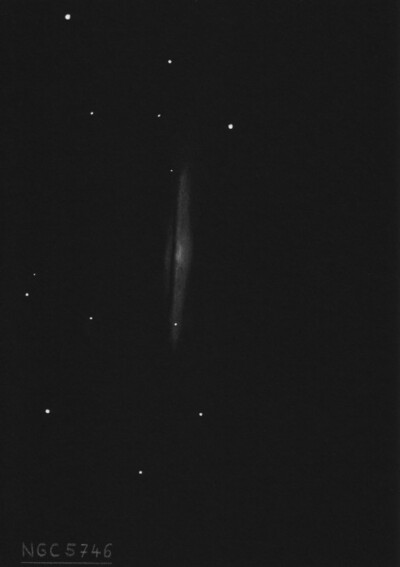
William Herschel discovered NGC 5746 = H I-126 = h1874 on 24 Feb 1786 (sweep 532) and recorded "eB, mE in the parallel [should be in the meridian], BN, 8 or 9' long." John Herschel made the single observation "a long pB ray with a pB nucleus; 3' long."
Lord Rosse made an early observation with the 72" on 25 Apr 1848. On 3 Apr 1875, Dreyer reported "there seems to be a split in the nebulosity following the nucleus." This clearly refers to the dust lane.
The RNGC declination is 10' too far south.
400/500mm - 17.5" (2/28/87): beautiful edge-on ~N-S, bright, fairly large, 4.5'x0.7', small bright core. A mag 15 star is at the south end 2' from the center. A dust lane is evident as a sharp light cut-off along the eastern edge. Located 5' SSE of mag 8.2 SAO 120633 and 20' WNW of 109 Virginis (V = 3.7).
900/1200mm - 48" (4/19/17): at 375x; gorgeous edge-on stretching nearly 7' NNW-SSE, It bulges nearly 1' in the core, though is much thinner towards the tips. Contains an intensely bright, elongated core with a rounder nucleus. The galaxy is sliced asymmetrically by a razor sharp, straight dust lane that splits the galaxy to the east of center, so that the main part of the galaxy is west of the dust lane. The portion of the disc on the east side of the lane is much fainter but shows up well as a thin strip, mostly visible in the central section east of the main section of the core. A bright mag 14 star is embedded on the south side, ~2' from the center. A mag 15.1 star is near the NNW end, off the east side and a mag 16 star is just west of the very NNE tip. Finally a mag 16+ star is superimposed just north of the core along the western flank ~0.6' from center. The galaxy is located 20' WNW of 109 Vir (V = 13.7) and mag 8.5 HD 129827 is 5' NW.
A small trio 17' to the west, consisting of LEDA 1210436 (V = 15.1), LEDA 1210907 (V = 17.1) and LEDA 1210022 (fits in a 2' circle) was picked up and observed at 697x. The light-travel time for all 3 is just over 1 billion years.
Notes by Steve Gottlieb